
The province of Monza and Brianza is a province in the Lombardy region of Italy.

Cernusco sul Naviglio is a town and comune in the Metropolitan City of Milan, Lombardy, northwestern Italy. With a population of 33,436 as of 2015 it is the 14th-largest municipality in the metropolitan city.

Brugherio is a comune (municipality) in the Province of Monza and Brianza in the Italian region Lombardy, located about 10 kilometres northeast of Milan. It was established December 9, 1866 unifying the suppressed municipalities of Baraggia, San Damiano and Moncucco, together with the villages of Bindellera, Cesena, Gelosa, San Paolo, Torazza, Occhiate and Increa.
The District of Monza was one of the four divisions of the Department of Olona, the province of Milan during the Napoleonic Italian Republic. It received the numeral III and its capital was Monza.
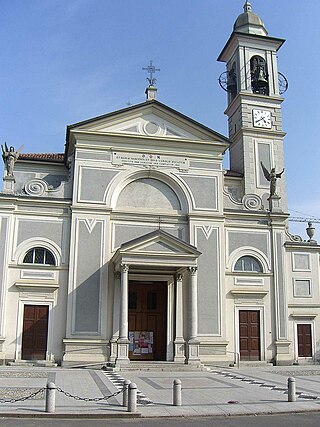
San Damiano is a hamlet in far north Brugherio, Italy. It is located between the Milan-Bergamo highway and the eastern road ring of Monza. It is 1.46 kilometres (0.91 mi) away from the town center.

The Palazzo Ghirlanda-Silva is a patrician building in the old town of Brugherio in the region of Lombardy, Italy. Built in the first half of the nineteenth century, it now houses the public library. It has an area of 1,992 m2 (21,440 sq ft), of which 1,407 m2 (15,140 sq ft) are used for library services, with the remaining space providing an exhibition room, an auditorium and offices.
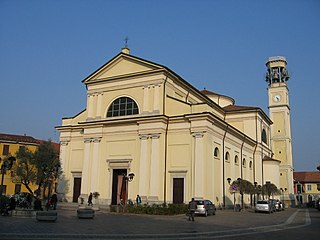
The Church of Saint Bartholomew is the cathedral and the oldest parish in Brugherio, Italy. It houses relics of the three Magi. It is characterised by its relatively high bell tower measuring 36.8 metres (121 ft).

Saint Lucius in Brugherio, Italy, is a small church dedicated to Saint Lucius in the grounds of the Villa Sormani. First located in Lugano, Switzerland, where it was a Franciscan chapel, the building was disassembled and transported to Brugherio, where its reconstruction was completed 17 years later.

Villa Scotti-Cornaglia-Noseda-Bertani, commonly known as Villa Fiorita, is a building in Lombardy, Italy, where the Brugherio Comune's headquarters are housed.
Villa Brivio is a 19th-century building in the Baraggia district of Brugherio, Italy. Owned by the municipality, it houses a residential center specializing in psychiatric therapy.
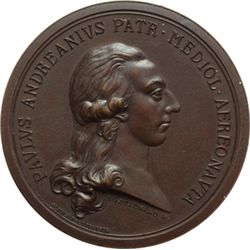
Paolo Andreani was an Italian who made the first balloon flight over Italian soil. He also made an exploration around the Great Lakes in North America.
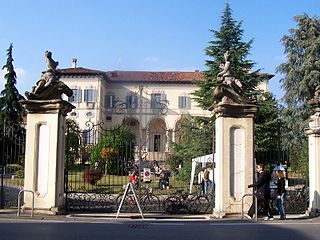
The baroque Villa Sormani is in the village of Moncucco in the city of Brugherio. The Villa Sormani was the site chosen by Count Paolo Andreani to demonstrate the first public balloon flight on Italian soil in 1784. In the grounds is a church that was moved from Switzerland.

Saint Ambrose is a small church which is an annex to the farmhouse that takes its name from it, in Brugherio, Italy.

The Chiesetta di Sant'Anna, or Small Church of Saint Anne, is a Roman Catholic church located in San Damiano, a hamlet of Brugherio, in the Province of Monza and Brianza, Italy.

Cascina Sant'Ambrogio is the oldest among the farmhouses in Brugherio, Italy. It is annexed to Saint Ambrose Church from which it takes its name.

Cassina Baraggia is a hamlet of Brugherio's municipality, which until 1866 was a separate municipality.

There are three plague crosses in Brugherio, in the province of Monza and Brianza in Lombardy, in northern Italy. They were erected after the plague that struck Monza and its surrounding area in 1576. The crosses are three that remain of four that marked where there were four altars used to celebrate religious services during the plague. The plague of 1576 was in fact called "the plague of Saint Charles", given the Bishop's closeness to those affected. Information about the plague can be found in the Bishop of Milan, Saint Charles Borromeo's notes.
The old farmhouses of Brugherio were agricultural structures typical of the Po-Valley in Lombardy, which gave its name to the surrounding areas as well, roughly corresponding to fractional towns in which Brugherio was divided. The union of the various small rural municipalities in which the territory was fragmented gave birth in 1866 to the municipality of Brugherio. Some are still visible: Bindellera, Casecca, Cattoni, Comolli, Dorderio, Guzzina, Increa, Modesta, Moia, Occhiate, Pareana, San Cristoforo, Sant'Ambrogio, San Paolo and Torazza.
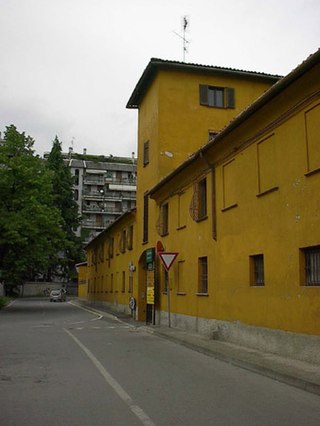
Cascina Guzzina is a farmhouse located in the southern part of Brugherio, on the border with Cologno Monzese. The name comes from gussetta, which formerly referred to the cocoon of the silkworm, whose breeding was widespread in the area. Agricultural complexes known as "agricultural courts", which once held prolific agricultural activity, are now civilian residences and businesses.

The State Archives of Milan, based at the Palazzo del Senato, Via Senato n. 10, is the state institution responsible, by law, for the preservation of records from the offices of state bodies, as well as public bodies and private producers. Slowly formed through the agglomeration of the various archival poles spread throughout Austrian Milan between the end of the 18th and the first half of the 19th century, the State Archives finally found its home in the former Palazzo del Senato under the direction of Cesare Cantù in 1886. Having become a research and training center of excellence under the directorships of Luigi Fumi and Giovanni Vittani, the State Archives of Milan since 1945 continued its role as a preservation institution, adapting to the needs of the times and developing the School of Archival Studies, Palaeography and Diplomatics attached to the Institute.


















